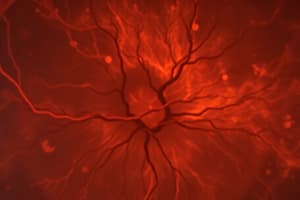Podcast
Questions and Answers
What is the characteristic OCT pattern seen in diabetic maculopathy where there is sponge-like thickening of retinal layers?
What is the characteristic OCT pattern seen in diabetic maculopathy where there is sponge-like thickening of retinal layers?
- Vitreo-retinal interface disorders
- Serous fluid accumulation under the fovea
- Large cystoid spaces involving variable depth of the retina (correct)
- Formation of drusen
Which OCT finding is indicative of serous retinal detachment?
Which OCT finding is indicative of serous retinal detachment?
- Serous detachment under the fovea (correct)
- Intraretinal fluid accumulation
- Thickening of retinal layers
- Spongiform appearance of the retina
In diabetic maculopathy, what does a taut posterior hyaloid membrane indicate in OCT imaging?
In diabetic maculopathy, what does a taut posterior hyaloid membrane indicate in OCT imaging?
- Concavity deformations
- Myopia
- Disappearance of foveal depression
- Tractional detachment of fovea (correct)
What OCT finding differentiates full-thickness macular holes from lamellar holes and pseudo holes?
What OCT finding differentiates full-thickness macular holes from lamellar holes and pseudo holes?
Which OCT characteristic is associated with hypopigmentation of RPE in retinal disorders?
Which OCT characteristic is associated with hypopigmentation of RPE in retinal disorders?
What OCT deformations are observed in OCT imaging for diabetic maculopathy?
What OCT deformations are observed in OCT imaging for diabetic maculopathy?
What do warm colors like red, yellow, and white denote in OCT imaging of the macula?
What do warm colors like red, yellow, and white denote in OCT imaging of the macula?
What is optically empty in OCT imaging of the macula?
What is optically empty in OCT imaging of the macula?
What does quantitive analysis in OCT imaging involve tracing?
What does quantitive analysis in OCT imaging involve tracing?
What kind of changes are analyzed in qualitative analysis of OCT scans?
What kind of changes are analyzed in qualitative analysis of OCT scans?
What do cold colors like green and blue denote in OCT imaging of the macula?
What do cold colors like green and blue denote in OCT imaging of the macula?
What is an example of an anomalous structure that can be found in OCT images of the macula?
What is an example of an anomalous structure that can be found in OCT images of the macula?
What can be assessed with OCT to determine full-thickness macular holes?
What can be assessed with OCT to determine full-thickness macular holes?
Which OCT pattern is characterized by sponge-like retinal thickening and hard exudates?
Which OCT pattern is characterized by sponge-like retinal thickening and hard exudates?
Which condition is associated with the elevation of the neurosensory retina and an optically clear space underneath it?
Which condition is associated with the elevation of the neurosensory retina and an optically clear space underneath it?
What is a characteristic feature of a Haemorrhagic Pigment Epithelial Detachment (PED) seen on OCT?
What is a characteristic feature of a Haemorrhagic Pigment Epithelial Detachment (PED) seen on OCT?
Which OCT pattern is associated with impending macular holes or foveal edema?
Which OCT pattern is associated with impending macular holes or foveal edema?
What is a common feature of Central Serous Retinopathy on OCT imaging?
What is a common feature of Central Serous Retinopathy on OCT imaging?
Flashcards are hidden until you start studying
Study Notes
Diabetic Maculopathy and OCT Patterns
- Characteristic OCT pattern shows sponge-like thickening of retinal layers, indicative of diabetic maculopathy.
- Taut posterior hyaloid membrane on OCT suggests potential traction affecting the macula in diabetic maculopathy.
- Diabetic maculopathy exhibits deformations such as retinal thickening, subretinal fluid, and hard exudates.
OCT Findings and Conditions
- Serous retinal detachment is indicated by the elevation of the neurosensory retina with an optically clear space beneath.
- Full-thickness macular holes differ from lamellar holes and pseudo holes based on distinct OCT findings, particularly the presence or absence of a full-thickness defect in the retina.
- Anomalous structures may appear on OCT images, including atypical tissue or abnormal fluid collections.
OCT Imaging Characteristics
- Warm colors (red, yellow, white) represent areas of increased thickness or pathological changes in the macula.
- Cold colors (green, blue) denote reduced thickness or normal retinal characteristics in OCT imaging.
- An optically empty space, often seen in OCT imaging, indicates the presence of fluid or cysts within the retina.
Quantitative and Qualitative Analysis
- Quantitative analysis in OCT involves tracing specific retinal structures or layers to assess thickness and volume.
- Qualitative analysis reviews changes in the retinal architecture, fluid presence, and exudate patterns on OCT scans.
Conditions and Features on OCT
- Haemorrhagic Pigment Epithelial Detachment (PED) shows characteristic features such as elevation of the retinal pigment epithelium along with accompanying hemorrhage.
- Impending macular holes or foveal edema is associated with a distinct OCT pattern reflecting changes in the fovea.
- Central Serous Retinopathy on OCT imaging typically demonstrates subretinal fluid accumulation and retinal elevation, particularly at the macula.
Studying That Suits You
Use AI to generate personalized quizzes and flashcards to suit your learning preferences.




